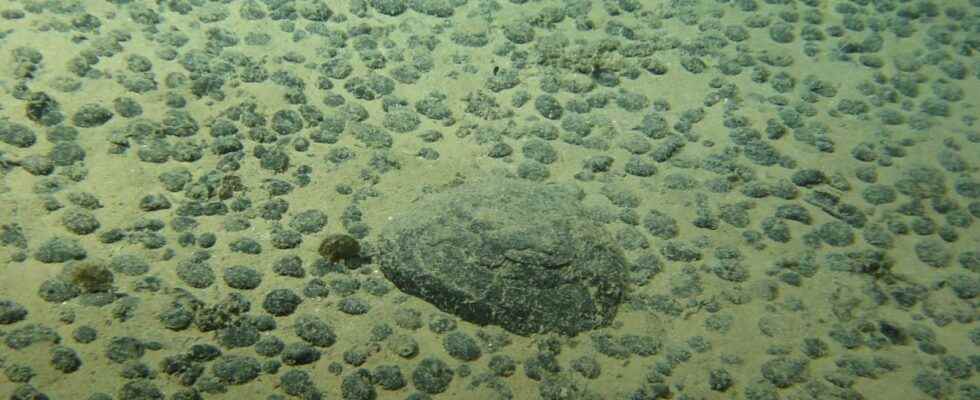You will also be interested
[EN VIDÉO] The ocean in danger from human exploitation and pollution In this video, Isabelle Autissier, the president of WWF France answers our questions on marine biodiversity. Here she talks about the exploitation of marine resources by humans and the risks associated with plastic pollution.
Today the metals essential to our industry come exclusively from deposits terrestrial. However, the continental crust is not the only potential source of minerals. The ocean floor also contains important quantities of metalsas the copperthe zincgold,moneythe lead… These mineral resources were identified some ten years ago, when the hydrothermal vents. These vents, generally located at the level of the ocean ridgesat about 4,000 meters deep, indeed spit hot fluids, acids and loaded in minerals and more particularly in sulphides polymetallic. By precipitating on contact with seawater, these sulphides will accumulate to form immense chimneysknown as black or white “smokers”.
Huge reserves of metals laid at the bottom of the oceans
However, these hydrothermal manifestations are very common at the level of ocean ridges. It is also an essential process in the Earth’s dynamics, since the hydrothermal circulation represents the main mechanism dissipation of the Earth’s internal heat. Scientists estimate that more than one million tons of sulphides iron are produced every hundred years by this mineralization process. Quantities similar to those land deposits.
The abyssal plains are also rich in minerals, and more particularly in manganeseiron, copper, nickel and cobalt. These metals are found in the form of small nodules, directly placed on the ocean floor, at very great depths (from 4,000 to 6,000 meters). Their origin is still poorly understood, but scientists suspect that the formation process here would be very slow.
It is therefore a veritable reserve of minerals lying in the depths of the oceans. A reserve that is of increasing interest to mining companies. With the increase in metal prices and in the face of growing demand, the idea of exploiting these resources has slowly come to the fore and it is now clearly being considered. Some companies have already embarked on the development of robotic exploration and exploitation equipment, capable of operating at great depths. These mining companies of a new kind are now waiting for authorization to exploit the seabed. An authorization that could arrive sooner than expected.
Scientists warn of the ecological impact of this type of exploitation
But the scientists of the European consortium responsible for evaluating the results of the first operating tests remain on the sidelines. If the economic stakes are enormous, the ecological considerations are just as important. Because it is necessary to assess what could be the impact of this kind of mining on the ecosystems of the ocean floor. For scientists, it is still far too early to know whether the damage caused would be permanent or whether it could only be considered “excessive”. The question is therefore not whether or not there will be damage, but how much.
Scientists estimate that each mining operation would lead each year to the destruction of 200 to 300 km2 biologically active surface at seabed level. The damage caused would therefore be enormous for the biodiversity and the functions of ecosystems, even if they remain difficult to estimate precisely.
Because it’s a fact, we know very little about deep-sea ecosystems. During the test phases, the scientists in charge of monitoring operations identified thousands of new species, previously unknown. How, in this case, to estimate the impact of a large-scale mining operation?
A two-year countdown
For scientists, a decade would certainly still be necessary to understand the functioning of these ecosystems and to envisage the start of exploitation in the best conditions. What species would be the most endangered by this type of operation? Which could easily relocate? The first studies seem to show that the damage would be visible on the ocean floor for several decades, affecting in particular the populations of sponges, corals and anemones.
But a small country comes to upset the calendar. Nauru, a small island state in the Pacific, has just defied the scientific community by imposing the reporting of conclusions on environmental impacts by 2024. A deadline far too short for scientists; 620 of them have also signed a petition to set up a moratorium until the consequences for the marine environment are clearly established. But, in fact, the start of deep-sea mining could well begin in two years.
Support an editorial team committed to popularizing science on Patreon!
Our mission ? Return the knowledge accessible to everyone.
We produce our own articles, investigations and reports every day, all on a human scale. Support us in this approach and this ambition.
Subscribe to Futura on Patreon!
Two subscription plans are offered to you with the following advantages:
- ” Futura ad-free »: get guaranteed ad-free access to the entire site for €3.29/month (+VAT).
- ” I participate in the life of Futura »: in addition to access without advertising, take part in the life of our independent media (votes, new content, surveys, etc.) for €6.29/month (+VAT).
Interested in what you just read?
